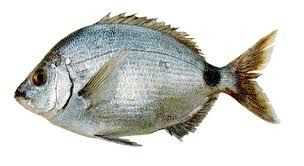South American Silver Porgy

Species Details
Diplodus Argenteus
Sparidae
Perciformes
Rocky Reefs, Coastal Areas, Clear Coastal Areas
1 - 5 lbs.
6" - 15"
South American Silver Porgy (Diplodus Argenteus) Description
The South American Silver Porgy, as its name states, is a silver-colored fish. Their most distinctive feature is the little black spot at the base of their tail. But the black spot isn’t the only dark mark it has. Sometimes, the South American Silver Porgy also has some faded dark bars that run vertically across their body against a silver-gold background.
A South American Silver Porgy has a small lump in between its eyes. Their dorsal and anal fins are also quite short and appear to be folded into the body. The fins of the South American Silver Porgy appear to be made of soft spines. Its fins appear to be translucent but it has bright gold highlights at the tip. Its pectoral fins however appear to be more of transparent golden-yellow color. The tail fin of a South American Silver Porgy has a deep “v” that splits the tail into two with the edges being rounded.
Diet and Size
South American Silver Porgy doesn’t eat much fish. They usually feed on algae or sometimes, some seagrass. As juveniles, they usually pick on seagrass or microalgae but that highly depends on their size. If they’re bigger and in a good mood, sometimes the South American Silver Porgy also spoils itself with a small crab or shrimp. They also eat barnacles, sea stars, and sea urchins.
A South American Silver Porgy’s max size is around 15 inches. However, their average size seems to waver between 6 to 8 inches long. As for weight, they can reach around 5 lbs. Average weight seems to vary between 1-3 lbs.
Interesting Facts about the South American Silver Porgy
- South American Silver Porgy can be confused with a Spottail Pinfish. To tell them apart, you’ll have to measure the dorsal fin.
- If the dorsal fin is 48% of the head length, that’s the South American Silver Porgy.
- Some people find the South American Silver Porgy tasty to eat.
- Tasty but they’re increasingly bony.
- South American Silver Porgy appear to be able to coexist with other fishes such as Chubs and Sea Breams.
- They appear to like colder weather. South American Silver Porgy usually spawn during late winter to early spring.
- Unlike other Porgy, the South American Silver Porgy would rather outrun their predator. They rely heavily on their speed and agility.
Fishing: How to catch a South American Silver Porgy
For those who lose bait at the piers, some anglers say that the South American Silver Porgy is the culprit. For hook size, some people would use either a size 8-10 hook in order to catch them. They grow up to only 6-8 inches and only bigger if in deeper waters. They’re also quite fast and have a tendency to just nibble on the bait before finally eating the whole thing. When going fishing, ask first yourself what size you’re going for. The South American Silver Porgy can grow up to 15 inches and if you’re going that big, you’ll have to use clams or sandworms as bait. Otherwise, squid will be much easier. A lot of anglers have mentioned that squid stays on hooks better.
Once you’ve figured that out, head towards the area. Unlike some of their Porgy cousins, the South American Silver Porgy don’t stay in their reefs. They stay on the shallower ends of the water. It takes a bit of sight-fishing but once you find them, make sure you have your bait and line ready. Make sure you have a braided line that will withstand the current. Make sure to also add some chum made from crushed clams and shrimp to attract them to your fishing spot.
Habitat and Distribution
South American Silver Porgy have a preference for clean water near rocky coasts and coral areas. They don’t wander too far into deep, staying in waters that are around 50 feet in depth. However, the South American Silver Porgy appear to have a preference for turbulent waters, probably as a way to help them keep moving. They can also be found in sandy shores and seagrass beds. They usually appear in schools as well.






